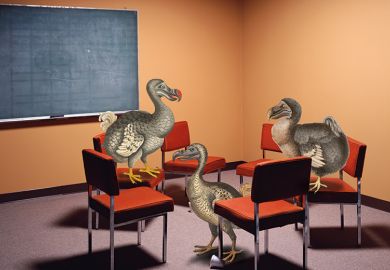Back in the 1990s, Alberta’s then education minister came up with an ingenious plan to freshen up the tired, old format of the university lecture: replace live lectures with video recordings. But these would be no ordinary videos. They were to be scripted by academics and delivered by professional actors.
As far as I know, the Alberta experiment did take place, but it evidently did not catch on. Nevertheless, we are now witnessing a renewed impetus to give the lecture a multimedia makeover – albeit without, thus far – the thespian doppelgänger.
If you teach in a UK university today, chances are that your lectures are being “spotifyed”: recorded and then streamed via digital platforms. Well over two-thirds of UK higher education establishments had jumped on the bandwagon by 2014, according to one recent study. It is no surprise to find that the new kids on the Silicon Valley block – the edtech companies – are heavily involved, offering not only lecture recording technology but also the ability to integrate recordings with e-learning systems. Yet they are not the only ones making bold statements about the educational pay-offs.
However, these claims are at the conjectural end of the evidence spectrum. By contrast, a growing body of educational research suggests that lecture capture, like so many pedagogical crazes before it, does not justify the hype.
One recent study confirmed our worst fears about what lecture capture technology would do to student attendance. The paper by Martin Edwards and Michael Clinton, from King’s College London, garnered headlines with its arresting conclusion that recording lectures results in a doubling of absenteeism. This finding is not consistently replicated by other studies, but it is not consistently contradicted, either; any meta-analysis of the links between lecture capture and attendance is far from conclusive, either way. What these studies do show, though, is that students – affirmed and patriotic natives of Digiland – still regard the live, analogue, face-to-face lecture or seminar as the main event.
Then why the negative impact on attendance found in Edwards and Clinton’s study? Their choice of experimenting on a second-year research methods module could be a partial answer. Anyone who has had the cruel misfortune to teach this subject will know that the typical student would sooner witness the slaughter of an infant bovine at a local abattoir than sit through a lecture on research methods.
Nor did they watch the recordings at home, with a beer to dull the pain. In fact, they were highly instrumental in their use of the lecture recordings, with the highest number of views occurring during the revision period. Other researchers have made similar observations. While students have consistently told researchers that they value recorded lectures as a learning tool, they use them only selectively and rarely watch them in their entirety.
One reason for that is surely the low production values. Web technologies allowed us to stream, platform share, upload and digitise, but the captured lecture remains a largely unedited hour-long recording of a monologue by a static figure – with shadowy PowerPoint slides projected in the background – from a single, fixed camera. For the digital generation, such content remains quite alien.
One possible solution is to “media enrich” recordings of lectures by interspersing them with relevant short films, infographics, quizzes or other interactive content. They can also be augmented with audio podcasts expanding on the themes of the lecture.
Developmental psychologists such as Janet Brain and John Black make the case that digital technologies provide a range of opportunities for this sort of multisensory learning.
And if this doesn’t work, we overworked academics could always hire a “between jobs” actor to declaim one or two of our lectures for the benefit of the camera. They would have more fun doing that than they would waiting on tables. Unless it was a research methods module, of course.
Michael Marinetto is a senior lecturer in public management at Cardiff Business School.
POSTSCRIPT:
Print headline: Video won’t kill the lecture
Register to continue
Why register?
- Registration is free and only takes a moment
- Once registered, you can read 3 articles a month
- Sign up for our newsletter
Subscribe
Or subscribe for unlimited access to:
- Unlimited access to news, views, insights & reviews
- Digital editions
- Digital access to THE’s university and college rankings analysis
Already registered or a current subscriber?







